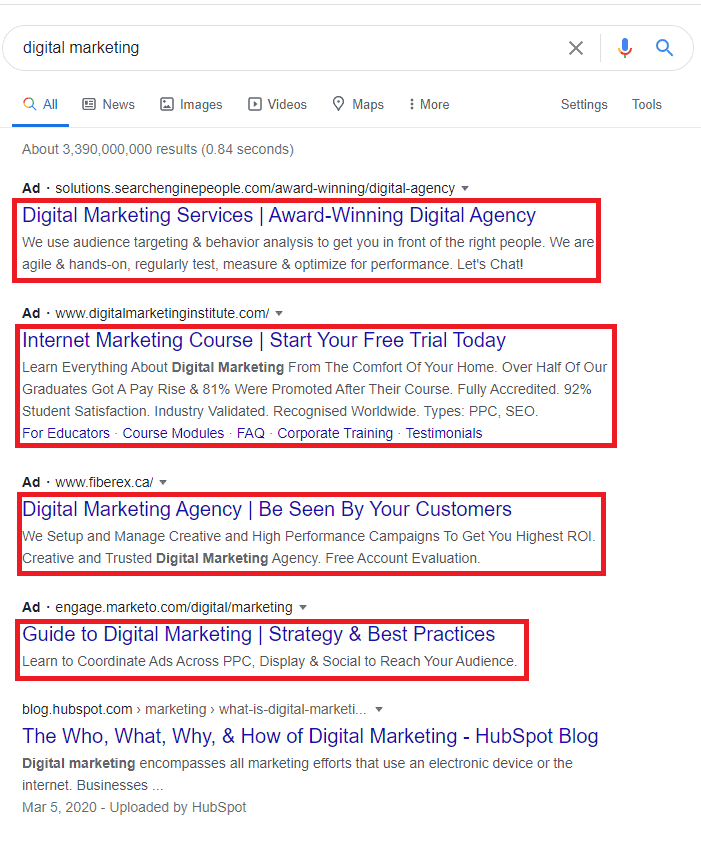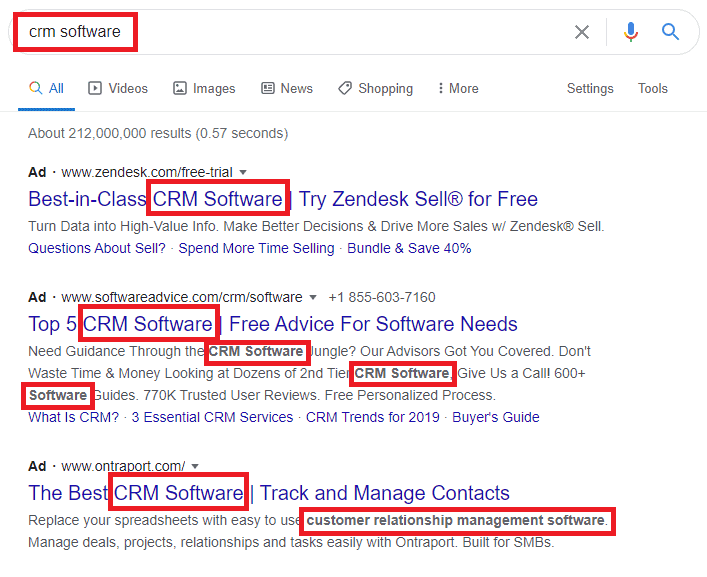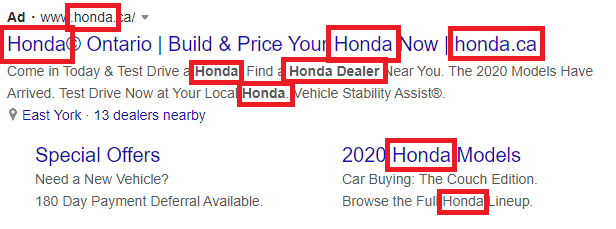What is search ad copy and what role does it play in the success of your PPC marketing campaigns?
Excellent search ad copy can make the difference between an impression and a click, but the space limitations associated with display and text ads can make it challenging to convey a meaningful message to your target audience. This is why skilled ad copywriters are among the most valued marketing professionals in the business.
As you learn how to create ad copy, you’ll be challenged to deliver a high-impact, targeted message that inspires action in as few words as possible. You’ll also discover that writing captivating ads for your target audience can be a lot of fun once you figure out the process.
To help you get there, we’ve created this short guide to help you get started on writing ad copy for your digital marketing campaigns. We’ll explain what Search Ad Copy is, why it’s important and share our 7 best tips to improve your Ad Copy based on best practices.
[optin-inline id=’wj3nwgvz35jz4o99retf’]
What is Search Ad Copy?
Search Ad Copy is a special name for the text that digital marketers use in search or display advertising campaigns.

Image: Ad Copy Examples from Ads in the Google Search Network
The goal of an advertisement is almost always to encourage the audience to click on the ad. As a result, ad copy needs to effectively communicate the value of your product, service or offer in a way that captures the attention of target audiences and persuades them to click through to your landing page.
Poor ad copy typically translates into a low-quality score, poor bidding performance, low impressions and a poor CTR to boot, so it’s important that digital marketers take the time to write amazing ad copy and test it thoroughly to make sure it appeals to the target audience.
7 Tips to Improve Your Ad Copy
Understand Space Limitations
When writing search ad copy, digital marketers will always have to work within space limitations.
For text ads on the Google Search Network, advertisers can write up to three 30-character headlines and two 90-character descriptions. Google usually shows all three headlines as part of your advertisement, but it may remove the third headline to make your ad look better on some devices. That gives advertisers just 240 characters of space in some cases to capture the attention of users and persuade them to click through.
Use Your Focus Keyword
If you’re writing an advertisement to be displayed when someone searches for “CRM software”, one of the best optimizations you can make is to include “CRM software” in your ad copy.

Image: Ad Copy Examples for “CRM Software” search. Google uses bold lettering to highlight exact-match keywords in the ad copy, drawing the attention of users and encouraging clicks.
That way, prospects who are presented with your ad will see their exact-match keyword in your ad copy. This creates the perception that your offer is highly relevant to their needs and encourages the user to click through to your landing page. Keywords are so important for optimizing your ad copy that Google has created a Dynamic Keyword Insertion (DKI) feature that inserts keywords into your ad copy automatically depending on what searchers type into their browser.
Don’t Be Too Repetitive
While you do want to mention your target keyword in your ad copy, it’s important to avoid repetition and keyword stuffing.

Image: By the time we finished reading this ad, the word “Honda” had lost all meaning. Maybe it works for Honda, but we wouldn’t recommend repeating your keyword this many times in your ad copy.
Mentioning your target keyword repeatedly is unnecessary and takes away valuable ad space that you could be using to create urgency, highlight an important benefit of your product or preemptively address an objection. It can also negatively impact your clicks and quality score if audiences find your ad copy too repetitive and off-putting.
As a general rule, include your focus keyword once near the beginning of your first headline and maybe once in the description.
Offer Something Valuable
Here’s the single biggest question that your audience has when they encounter one of your text ads online:
What’s in it for me?
If you’re not offering something of value, how could you possibly persuade a rational person to click on your advertisement?
Your ad copy needs to entice users by giving them a suggestion about what you’re offering so they’ll actually be excited to click through to your landing page for more information. It’s also important that your offer connects with what users actually want when they see your ad – that’s part of effective audience and keyword targeting.
If you’re selling a product or service, use your ad copy to highlight the most important features and benefits. If you’re working on a lead generation campaign with emails or webinars, use your ad copy to tell audiences exactly how those things are going to deliver value and solve their problems.
Make Ad Copy Contextually Relevant
A great way to improve your ad copy is to make it more contextually relevant.
One way is using Google’s Dynamic Location Insertion (DLI) feature, which lets you dynamically customize your ad copy with location-specific pricing, inventory availability and calls-to-action.
Another effective tactic we’ve seen in Google search ads is referencing an upcoming holiday like Mother’s Day or Valentines Day and encouraging audiences to shop for a gift.
Delivering ad copy that is more customized and tailored for individual uses increases relevance, which ultimately drives CTR, conversions and overall search campaign performance.
Include Social Proof
Social proof works simply because users are often more likely to undertake a specific action if they perceive that others around them are doing the same thing or have done so in the past with good results.

Image: This ad includes social proof to convince prospects that it is both trustworthy and effective at advising buyers about software purchases.
Including social proof is a great way to show off your successes and instantly build trust with audiences, even when you have just a few characters to spare. The impact of social proof on customer response makes this one of the most effective marketing strategies we’ve seen for writing ad copy.
Include a Powerful Call to Action (CTA)
A CTA is the part of your ad copy where you directly ask the audience to take action by clicking through to your landing page.

Image: These ads for stock image websites all include a call to action.
Your CTA should clearly tell the audience what steps you want them to take after clicking on your advertisement, whether that’s redeeming a free trial offer, subscribing to a service, or purchasing a product. The CTA is often found at the end of your ad copy, but you’ll also find plenty of examples like the ones pictured where the CTA can be found in the middle of the description.
We’d usually recommend putting the CTA at the end of your ad so potential customers read through all of the features and benefits that you highlight before you ask them to click.
Summary
Thanks for reading through our list of recommendations for improving your search ad copy!
As you gain more experience writing ad copy, you’ll be able to quickly whip up persuasive ads that will earn you higher click-through rates when they feature on search engine results pages. By following these best practices, you should be in good shape to create some solid text ads, but don’t be afraid to get creative and experiment with new ideas for connecting with your target audience.
We hope these ad copywriting tips help you create more high-performing search ads.
-
 CEO
Garrett Mehrguth
CEO
Garrett Mehrguth
Did you enjoy this article?
Share it with someone!
